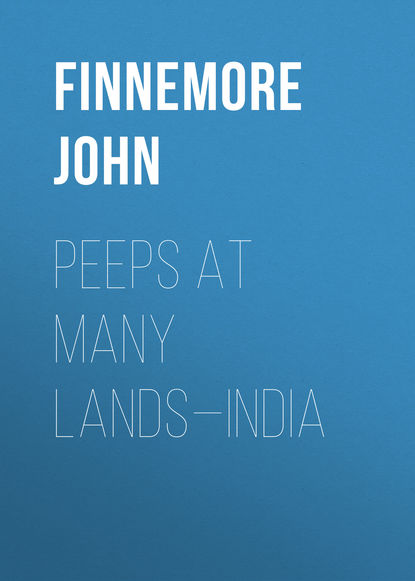По всем вопросам обращайтесь на: info@litportal.ru
(©) 2003-2024.
✖
Peeps at Many Lands—India
Настройки чтения
Размер шрифта
Высота строк
Поля
The most striking thing in Udaipur is the vast palace of the native Prince. The most beautiful things are the two lovely water palaces which stand on islands in the lake.
The former is entered by a fine triple-arched gateway. "Above this gateway soars the great white fabric, airy, unreal, and fantastic as a dream, stretching away in a seemingly endless prospective of latticed cupolas, domes, turrets, and jutting oriel windows, rising tier above tier, at a dizzy height from the ground. A single date-tree spreads its branches above the walls of the topmost court, at the very apex of the pile."
From the foot of the ridge on which stands this glittering pile of splendid masonry the dark blue lake stretches away, its surface broken by two islands, each of which is occupied by a water palace of wonderful beauty. Here one may roam through miles of courts, saloons, corridors, pavilions, balconies, terraces, a fairyland of splendour, in which every room, every gallery is decorated with the most exquisite art. And all this has been wrought by the hand of man, not merely the marvellous palaces, but the very lake itself. This site was once a desert valley, but immense wealth and boundless power have filled the great hollow with blue water, and littered its shores with temples and palaces and pavilions, presenting a scene which, for charm of colour and beauty of outline, can nowhere be surpassed.
CHAPTER IV
IN THE PUNJAB
Beyond the wide desert which stretches along the north-western border of Rajputana lie the plains of the Punjab, running up to the foot-hills of the Himalayas. The Punjab (the Land of Five Rivers), where the Indus and its tributaries roll their waters to the Arabian Sea, is, above all and beyond all, the battlefield of India. For it was upon these plains that the onsets of invaders first fell. Greeks, Persians, Afghans – swarm after swarm poured through the only vulnerable point of Northern India, and fought out on the plains of the Punjab the struggles which meant for them victory or disastrous retreat.
The last native rulers of the Punjab were the finest ones of all – the Sikhs. The Sikhs, a nation of fanatics and heroes, fought the Moslems for hundreds of years, and the prize was the rule of the Punjab. The Sikhs won, and formed a barrier behind which India was safe from the savage Moslem tribes of the north-west.
The Sikhs are a warrior race pure and simple. They make splendid soldiers under white officers, and the fine Sikh regiments are the pride of our native Indian army. They did not yield up the Punjab to British rule without a stern struggle. They were noble foes, and they proved noble friends. They accepted the British Raj once and for all. Within ten years after their conquest the Indian Mutiny broke out. The Sikhs stood firm, and aided the British with the utmost gallantry and devotion.
The Sikh is a fine, tall, upstanding fellow, with an immense beard and a huge coil of hair. This follows on his belief that it is impious either to shave or to cut the hair. He holds tobacco in abhorrence, and worships his Bible, which is called the Granth. In every Sikh temple sits a priest reading in a loud voice from the Granth, while beside him an attendant priest fans the holy book with a gilt-handled plume of feathers.
The most famous Sikh temple is at Amritsar, the holy city of the Sikh faith. Here is the Pool of Immortality, and in the midst of the lake rises the Golden Temple, standing on an island. From the gates of the city a throng of stalwart, bearded Sikh pilgrims sets always towards the Golden Temple. You follow in their train, and come suddenly upon a wide open space. It is bordered by a marble pavement, and within the pavement lies the famous Lake of Immortality. The Golden Temple rises before you, glittering with blinding radiance in the hot sunshine, and mirrored in the smooth water which runs to the foot of its walls.
But you may not yet enter the sacred place and walk round the lake and see the temple. At the gates you are stopped, and your boots taken from you, and silken slippers tied on in their place. If you have tobacco in your pockets that, too, must be handed over, and left till you return, for tobacco would defile the holy place. Then you are led round by a Sikh policeman, who will show you the temple and the hallowed ground.
The marble pavement around the sacred lake is dotted with groups of priests and pilgrims, and behind the pavement stand palaces of marble, owned by great Sikh chiefs who come here to worship. Here and there are flower-sellers weaving long chains of roses and yellow jasmine to sell to worshippers who wish to make offerings. A teacher with a little band of students around him is seated beside the pool, and in a shady corner is a native craftsman busy fashioning wooden spoons and combs, and other trifles, which he sells as souvenirs of the shrine.
The Golden Temple itself is gained by a causeway across the lake, and the causeway is entered through a magnificent portal with doors of silver, and four open doors of chased silver give access to the sanctuary itself. Here sits the high-priest reading the Granth, and before the holy book is spread a cloth, upon which the faithful lay offerings of coins or flowers.
From Amritsar, the holy city, to Lahore, the capital of the Punjab, is only some thirty miles. Lahore is a large town of great importance as a military station, and many troops are quartered in the grand old fort built by the Mogul Kings. Some of the palaces which once filled this ancient fortress still show traces of their former splendour. There are sheets of striking tilework, with panels of elephants, horsemen, and warriors worked in yellow upon a blue ground. There are marble walls inlaid most beautifully with flowers formed of precious stones. But many of the halls have been converted into barracks, and in spots where once an Emperor smoked his jewelled "hubble-bubble," surrounded by a glittering Court, Tommy Atkins, in khaki and putties, with his helmet on the back of his head, now puffs calmly at a clay pipe.
Lahore has streets which display some of the finest wood-carving in India. These streets lie within the city, the old part of the town, enclosed by brick walls sixteen feet high, and entered by thirteen gates. In one street every house has a balcony or jutting window of old woodwork, carved into the most beautiful or fantastic designs, according to the fancy of the owner who built and designed it long ago. The balconies are of all sizes and shapes, and their line is delightfully irregular. The walls, too, are painted and decorated lavishly, and domed windows are adorned by gaily-tinted peacocks worked in wood or stucco. The splendid woodwork, the shining beauty of paint and courses of bricks richly glazed in red and blue, the gay crowd which throngs the way – all these things combine to form a striking and splendid picture.
At the end of this marvellous street rise the tall minarets of the Great Mosque, and close by is the fine tomb where lies Runjit Singh, the greatest of the Sikh rulers. Under him the Sikhs rose to the height of power in India; but a few years after his death, in 1839, the Punjab passed into our hands.
CHAPTER V
AMONG THE HIMALAYAS
India is bounded and guarded on the north by one of the grandest mountain-chains in the world. This is the mighty range of the Himalayas, which stretches a row of lofty peaks from east to west, as if to shut up India behind a gigantic wall.
There are very few points where this vast range can be crossed, and then only with the greatest difficulty. The most famous pass of all lies in the north-west, the well-known Khyber or Khaibar Pass leading into Afghanistan. Through this pass invader after invader in age after age has poured his troops into the fertile plains of Hindostan.
At this point Alexander the Great at the head of a Greek army crossed the Indus and marched into India. To this day there are left in the land tokens of that far-off raid. The Indian hakims, the native doctors, practise the Greek system of medicine, and the influence of the invaders is seen in old Indian coins which turn up with Greek inscriptions upon them, in statues which are found in the soil, as full of Greek feeling as any in Athens itself.
But it is now a task for British brains and hands to see to it that no fresh invader swoops through the pass, and it is very strictly guarded. In itself the pass presents many difficulties. The way lies through tremendous ravines, beside which tower precipices of stupendous height, and the road could easily be blocked and destroyed at many points. The people who inhabit this region are also of a very savage and dangerous character. They are called Afridis, and belong to wild hill-tribes, who are always ready for a fray, all the more so if there is a little plunder to be gained by it.
With these fierce and lawless people the British officers have come to an arrangement: that for two days a week the Afridis themselves shall furnish soldiers to guard the pass. For this duty an annual payment is made, and thus the Khaibar Pass is quite safe on Tuesdays and Fridays. On other days the traveller must look out for himself. He must keep a wide eye open for the Zakka Khels, a notorious Afridi tribe. When a son is born to a Zakka Khel woman she swings him over a hole in a wall, saying, "Be a thief! be a thief!" And a thief he is to the end of his days.
Among the Himalayas to the north-east of the Khyber Pass lies the beautiful vale of Kashmir, or Cashmere (the Happy Valley). Cashmere is a lofty plain, yet it is not a plateau, for you go down into it from every side. It is so high that its climate is nearer to that of England than any other part of India. The summer is like a fine English summer, but a little hotter, and with more settled weather. In winter the snow lies on the ground for two or three months, but about the end of February the snow disappears, and the spring bursts out, and the vale becomes beautiful with the tender green of growing crops and grass and a profusion of most lovely flowers. The scenery is very fine. Around and far off is the great wall of lofty mountains, which encompass the plain with glittering slopes of eternal snow. The vale itself is dotted with hamlets and villages, with fields waving with corn and rice, with meadows, with orchards of mulberry- and walnut-trees, with forests of giant plane-trees.








